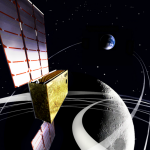
Global Space News: NASA’s Insight Mission draws to a close
The accumulation of dust on the solar panels of NASA’s InSight Mars Lander is set to bring the mission to a close this summer. InSight (Interior exploration using Seismic Investigations, Geodesy and Heat Transport) brought the first seismometer to Mars, detecting more than 1,300 “marsquakes” rippling through the planet. The detection of these quakes has huge scientific value, as their properties are affected by the planet interior, revealing hidden structure from core to surface that is essential to understand the formation and evolution of that world.

By measuring the speed and shape of the marsquakes, Insight discovered Mars has a surprisingly large core. Like the Earth’s core, Insight also confirmed that the Mars core is molten. As the much smaller Mars would have been expected to cool away its heat from formation more efficiently than the Earth, the Martian core might have solidified. However, Insight also discovered that the density of Martian core is low, suggesting the presence of lighter elements mixed into the main core-forming elements of iron and nickel that could have slowed this cooling.
Extraterrestrial seismometry will not end with InSight. NASA’s Dragonfly mission is scheduled to launch in 2027, with the destination of Saturn’s moon, Titan. Dragonfly will carry a JAXA-developed seismometer to peer beneath the surface of the icy moon. Unlike Insight, Dragonfly is a multi-rotor drone that will fly to multiple locations on the Titan surface. This means that the JAXA seismometer has been developed to be incredibly light, weighing just 300g compared to Insight’s seismometer package of 11kg. More about the Dragonfly seismometer design can be found in our Cosmos post here.

While Insight and Dragonfly will carry a single seismometer, JAXA has plans to place an array of sesimometers on our own Moon. “Moonquakes” were detected by seismometers carried by the Apollo astronauts, and are thought to be generated by the tidal pull from the Earth’s gravity flexing the Moon to generate a quake. Understanding the Moon’s interior will not only help our understanding of the Earth-Moon system, but also boost the knowledge needed for a future human base, says Saiki Takanao from the Department of Interdisciplinary Space Science.
InSight’s long-term observation of the Mars quake and the investigation of the interior structure of Mars are truly amazing achievements. Exploration of the interior structure is a major theme for future exploration of the Solar System. Japan, a country of many earthquakes, is also considering a plan to place its own highly sensitive lunar seismometers on the Moon in a network to learn more about the interior structure of the Moon, which is still uncertain. This will provide important knowledge for the construction of a lunar base, a lunar observatory, and other large-scale structures on the Moon.
Saiki Takanao, Department of Interdisciplinary Space Science
While seismometry is the main method to elucidate the internal structure of a rocky world, there are alternatives if the hidden interior is not solid. The ESA-led JUICE (JUpiter Icy moons Explorer) mission will launch in 2023 to explore Jupiter’s icy moons, which are believed to harbour giant hidden oceans below their icy surface. JAXA has contributed hardware to several of the instruments onboard JUICE, including the Ganymede Laser Altimeter (GALA). With GALA, explains Professor Saito Yoshifumi from the Department of Solar System Science, details of the hidden ocean of the moon, Ganymede, could be revealed.
I have always been very interested in the interior structure of the planets so I am excited about the news of Martian seismic wave observation by Insight. As planetary exploration progresses, the interior structure of the extra-terrestrial bodies will become clearer. JUICE (Jupiter Icy Moons Explorer) will perform flyby observations of the icy moons of Jupiter: Europa, Ganymede, and Callisto, and then become an orbiter of Ganymede to explore the liquid ocean (subsurface ocean) believed to exist inside the icy moons.
Yoshifumi Saito, Project Manager for JUICE-ISAS
JUICE-GALA (Ganymede Laser Altimeter) is one of the onboard instruments on JUICE where ISAS is providing a part of the instrument. GALA will measure the distance between the JUICE satellite and Ganymede to detect changes in the shape of Ganymede during the around Jupiter and reveal the structure of Ganymede’s subsurface ocean. JUICE will be launched in April next year. Please look forward to JUICE’s future activities.
Insight gave us one of our first looks at a planet’s structure, but its legacy will continue and reveal far more about the formation of planets and moons than we have ever seen before.
“Global space news” is a chance for us to highlight important developments across the world and share our excitement of these achievements.
Further information:
Global Space News: NASA’s Insight mission peers inside Mars


 Previous Post
Previous Post Next Post
Next Post






